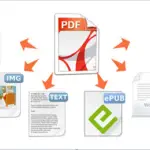In today’s digital age, readers expect more than just text on a screen—they seek engaging, interactive, and visually appealing content. ePub3, the latest iteration of the widely adopted ePub standard, is specifically designed to enhance eBook design and functionality. For publishers looking to elevate their eBook offerings, converting to ePub3 provides many benefits that traditional eBook formats simply cannot offer.
Let’s explore how ePub3 conversion can transform your eBook content.
1. Dynamic Multimedia Integration
With ePub3, publishers can seamlessly incorporate multimedia elements such as audio, video, and animations, providing a richer reading experience. For instance, educational eBooks can embed video explanations or audio guides that help reinforce learning. This capability adds depth and engagement, allowing your eBook to go beyond static text and images.
- Example: A travel eBook with embedded videos of destination highlights, bringing places to life for readers.
- Benefit: Increases reader engagement by offering a multisensory experience.
2. Advanced Interactivity
Interactive features are a cornerstone of ePub3’s design. Publishers can now include elements like quizzes, pop-up footnotes, clickable diagrams, and navigable tables of contents. This interactivity is particularly valuable in genres like education, training, and children’s books, where hands-on learning or engagement is essential.
- Example: An educational eBook with end-of-chapter quizzes and interactive flashcards for review.
- Benefit: Engages readers actively, enhancing knowledge retention and user satisfaction.
3. Enhanced Accessibility Features
ePub3 supports accessibility features, making content more inclusive. From adjustable font sizes and high-contrast modes to compatibility with screen readers, ePub3 ensures your eBooks are accessible to all readers, including those with disabilities. For publishers, this means reaching a broader audience and meeting accessibility standards.
- Example: A textbook with scalable text and alt text for images, optimized for visually impaired readers.
- Benefit: Expands audience reach and complies with global accessibility standards.
4. Flexible Layout Options
ePub3’s reflowable layout allows content to adapt seamlessly across different screen sizes and orientations, enhancing readability on any device. Additionally, fixed layouts are available for publications like graphic novels or cookbooks where design consistency is key. This flexibility gives publishers the control they need to maintain their visual integrity, regardless of device.
- Example: Children’s books with fixed-layout pages that maintain image and text alignment across all devices.
- Benefit: Ensures a consistent and high-quality reading experience.
5. Global Language and Format Support
Supporting multiple languages and text directions, ePub3 is ideal for publishers with an international reach. Right-to-left (RTL) languages, vertical text, and complex characters are all compatible, making it easy to produce multilingual editions and adapt to various linguistic needs.
- Example: Publishing an eBook in both English and Arabic, with smooth transitions between languages.
- Benefit: Facilitates global distribution and simplifies localization efforts.
Conclusion: Elevate Your eBooks with ePub3
ePub3 conversion empowers publishers to create eBooks that are not only visually appealing but also functional and inclusive. From enhanced multimedia to global language support, ePub3 meets the diverse needs of modern readers, allowing publishers to stay competitive in a digital-first world. For those looking to elevate their eBook design and functionality, ePub3 conversion is an investment in both quality and audience engagement—helping your content stand out in a crowded digital landscape.
Consider making the switch to ePub3 to offer readers an immersive, accessible, and high-quality reading experience that goes beyond traditional eBooks.
To know more: https://academian.com/services/
